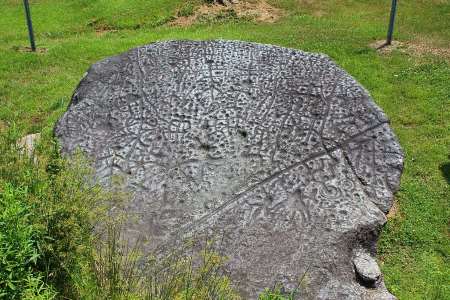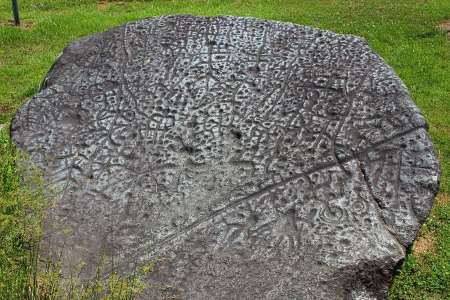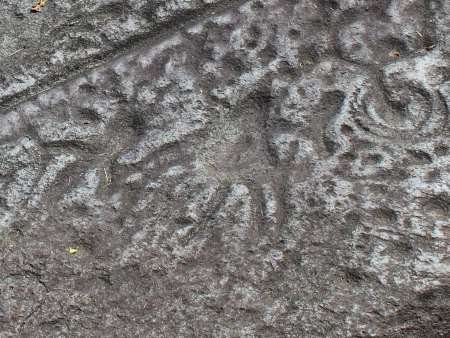



Judaculla Rock: A Cherokee Cultural Heritage Site
For generations, the Cherokees lived in clusters of independent towns located along river bottoms throughout the southern Appalachians. Their traditional territory extended into eight modern states. Judaculla Rock is thirty miles from the Qualla Boundary, home of today's Eastern Band of Cherokee Indians. The petroglyph is near Cullowhee, once home to a historic Cherokee town and the site of a council house mound. The rock may have served as a boundary marker for Cherokee hunting grounds, which were closely guarded by the legendary giant and master of animals, Judaculla (Tsu-tla-ka-la).
What do these markings tell us?
The markings on Judaculla Rock were made by Cherokee Indians at different points in time. Over 3,000 years ago, they began to quarry soapstone from the surface of Judaculla Rock, chipping off pieces to carve into bowls. The scars that remain from these activities can be seen at the lower left of the rock, where soapstone bowl material was cut from the main rock.
It was not until much later, after quarrying at the site had ceased, that the petroglyphs were inscribed into the rock.
Archaeologists estimate that most of the glyphs are between 300 & 1,500 years old
For generations, the Cherokees lived in clusters of independent towns located along river bottoms throughout the southern Appalachians. Their traditional territory extended into eight modern states. Judaculla Rock is thirty miles from the Qualla Boundary, home of today's Eastern Band of Cherokee Indians. The petroglyph is near Cullowhee, once home to a historic Cherokee town and the site of a council house mound. The rock may have served as a boundary marker for Cherokee hunting grounds, which were closely guarded by the legendary giant and master of animals, Judaculla (Tsu-tla-ka-la).
What do these markings tell us?
The markings on Judaculla Rock were made by Cherokee Indians at different points in time. Over 3,000 years ago, they began to quarry soapstone from the surface of Judaculla Rock, chipping off pieces to carve into bowls. The scars that remain from these activities can be seen at the lower left of the rock, where soapstone bowl material was cut from the main rock.
It was not until much later, after quarrying at the site had ceased, that the petroglyphs were inscribed into the rock.
Archaeologists estimate that most of the glyphs are between 300 & 1,500 years old
Judaculla Rock Petroglyphs
The Judaculla Rock cultural and archaeological site is one of America's most significant historical places. Revered through the ages by the Cherokee, the site's rich cultural legacy makes this one of their most important ancestral places. The rock is carved with approximately 1,548 designs, more than any other known petroglyph boulder in the eastern United States. Petroglyphs are images and designs engraved within a rock's surface to symbolize importatn places, stories or events.
Archaeologists believe intensive use of the site began over 3,000 years ago when the soapstone boulders were quarried for making bowls. Petroglyph carving began around 1,500 years ago and likely continued
until European settlement disrupted Cherokee life ways & traditions some 300 years ago.
The Judaculla Rock cultural and archaeological site is one of America's most significant historical places. Revered through the ages by the Cherokee, the site's rich cultural legacy makes this one of their most important ancestral places. The rock is carved with approximately 1,548 designs, more than any other known petroglyph boulder in the eastern United States. Petroglyphs are images and designs engraved within a rock's surface to symbolize importatn places, stories or events.
Archaeologists believe intensive use of the site began over 3,000 years ago when the soapstone boulders were quarried for making bowls. Petroglyph carving began around 1,500 years ago and likely continued
until European settlement disrupted Cherokee life ways & traditions some 300 years ago.
What is a petroglyph?
Petroglyphs - a type of rock art - are images inscribed into rocks. Native people made these markings by pecking, abrading, or scratching rocks. Some were created or used during rituals or ceremonies, and others may tell a story.
Petroglyphs may have been used to mark an important event or serve as a map. While rock art is found all over the world, you are about to visit the most extensive petroglyph site in North Carolina.
Petroglyphs - a type of rock art - are images inscribed into rocks. Native people made these markings by pecking, abrading, or scratching rocks. Some were created or used during rituals or ceremonies, and others may tell a story.
Petroglyphs may have been used to mark an important event or serve as a map. While rock art is found all over the world, you are about to visit the most extensive petroglyph site in North Carolina.

Who is Judaculla?
According to Cherokee legend, Judaculla was a slant-eyed giant who lived high up in the Balsam Mountains. He guarded his hunting grounds from Judaculla's Judgement Seat, today known as Devil's Courthouse, a site reached from the Blue Ridge Parkway.
Once, a party of disrespectful hunter came through
his land, Judaculla chased them down the mountain. With a mighty leap, the angry giant landed near Caney Fork on a large boulder. Putting his hand down to steady himself, he left his mark on the rock's surface. The impression of his hand can still be seen at the lower right of the rock.
Judaculla's marks have also been seen on other boulders throughout Cherokee lands, including near the Mother-town of Kituwah, a sacred and prominent Cherokee religious center.
According to Cherokee legend, Judaculla was a slant-eyed giant who lived high up in the Balsam Mountains. He guarded his hunting grounds from Judaculla's Judgement Seat, today known as Devil's Courthouse, a site reached from the Blue Ridge Parkway.
Once, a party of disrespectful hunter came through
his land, Judaculla chased them down the mountain. With a mighty leap, the angry giant landed near Caney Fork on a large boulder. Putting his hand down to steady himself, he left his mark on the rock's surface. The impression of his hand can still be seen at the lower right of the rock.
Judaculla's marks have also been seen on other boulders throughout Cherokee lands, including near the Mother-town of Kituwah, a sacred and prominent Cherokee religious center.
Hand print of Judaculla


Legend of Judaculla Rock
Written by: Jonathan Martin
Within the Nantahala National Forest in Jackson County, an interesting petroglyph (a prehistoric carving) rests in an open pasture. Known as the Judaculla Rock, many tourists and archeologists have visited the mystic rock to admire the markings and develop theories on the origin of the large landmark.
The Judaculla Rock is a soapstone rock with numerous Native American symbols etched throughout. It is a deeply
associated with the Tsu’kalu or Judaculla (meaning “he has them slanting” or “slant-eyed giant”) legend of the Cherokee. Like most Native American tribes, the Cherokee believed the spirit world influenced the things of the physical world and that every man and piece of nature (animals, weather, plants, etc.) exhibited a spirit. The gods of the spiritual world controlled the spirits, and often times the Cherokee relied on a mediation between the physical world and the spiritual world; Judaculla Rock served as a landmark for a the hunting god.
According to the tale, Judaculla was a giant who had slanted eyes along with superhuman-like powers. He selected a bride from the Cherokee tribe, but the bride’s mother and brother wanted their sister back after Judaculla had taken her into the spirit world. To see the bride, both the mother and brother had fasted for seven days outside a cave in which their sister lived with the other god spirits. However, the brother was famished after six days, and he ate a piece of meat before the end of the seventh day. Judaculla came back into the physical world to punish the bride’s brother, and he entered through the Judaculla Rock, believed by the Cherokee as “the spirit’s stepping-stone into the physical world of mortal beings”
In his fit of anger, Judaculla killed the bride’s brother with a thrash of lightning, grieving the bride to the point that she wished to return to her earthly tribe. Yet, Judaculla refused to give up his wife and he compromised with the Cherokee to keep her in the spirit world. Judaculla allowed all brave and faithful tribesmen and women to enter into an eternal life in the spirit world after their deaths. After his deal with the Cherokee, the tribe discovered the markings on the Judaculla Rock, and they have since been believed to tell of how one can enter into the spiritual world.
The Cherokee declared Judaculla Master of all Game Animals and the sustainer spirit of the tribe. Tribesmen and women started several rituals that focused on honoring the giant. Other Cherokee traditions hold the Judaculla Rock to be a remnant of Judaculla’s great leap from his high mountaintop.
For those who doubt the ancient Judaculla tradition, theories have been proposed in regards to the rock’s possible practical origins. Some historians believe the etchings to be a map of the Battle of Taliwa where the Cherokee defeated the Creek tribe in 1755. Yet, archeologists and geologists refute this theory because the Cherokee were not known for etching their history on stone or rock. Subsequent archeologists have theorized that the Judaculla Rock was a remnant of a pre-historic tribe who lived at the end of the Ice Age.
Despite the mystery of the Judaculla Rock, the place remains a historic landmark to the Eastern Band of Cherokee. Some adamant Cherokee tribesmen continue to fast at the site of the rock to understand the ancient message left by Judaculla.
Recent restoration efforts have been made to preserve what is left of the sacred rock.
Sources
“Judaculla Rock.” North Carolina Highway Historical Marker Program website. A Division of the North Carolina Department of Cultural Resources. (accessed January 10, 2011).
“Judaculla Rock.” William S. Powell, ed. Encyclopedia of North Carolina (University of North Carolina Press:
Chapel Hill, NC 2006).
Mountain Ghost Stories And Curious Tales of Western North Carolina. Randy Russell and Janet Barnett. Sixth Printing, 1988, 1996.
Written by: Jonathan Martin
Within the Nantahala National Forest in Jackson County, an interesting petroglyph (a prehistoric carving) rests in an open pasture. Known as the Judaculla Rock, many tourists and archeologists have visited the mystic rock to admire the markings and develop theories on the origin of the large landmark.
The Judaculla Rock is a soapstone rock with numerous Native American symbols etched throughout. It is a deeply
associated with the Tsu’kalu or Judaculla (meaning “he has them slanting” or “slant-eyed giant”) legend of the Cherokee. Like most Native American tribes, the Cherokee believed the spirit world influenced the things of the physical world and that every man and piece of nature (animals, weather, plants, etc.) exhibited a spirit. The gods of the spiritual world controlled the spirits, and often times the Cherokee relied on a mediation between the physical world and the spiritual world; Judaculla Rock served as a landmark for a the hunting god.
According to the tale, Judaculla was a giant who had slanted eyes along with superhuman-like powers. He selected a bride from the Cherokee tribe, but the bride’s mother and brother wanted their sister back after Judaculla had taken her into the spirit world. To see the bride, both the mother and brother had fasted for seven days outside a cave in which their sister lived with the other god spirits. However, the brother was famished after six days, and he ate a piece of meat before the end of the seventh day. Judaculla came back into the physical world to punish the bride’s brother, and he entered through the Judaculla Rock, believed by the Cherokee as “the spirit’s stepping-stone into the physical world of mortal beings”
In his fit of anger, Judaculla killed the bride’s brother with a thrash of lightning, grieving the bride to the point that she wished to return to her earthly tribe. Yet, Judaculla refused to give up his wife and he compromised with the Cherokee to keep her in the spirit world. Judaculla allowed all brave and faithful tribesmen and women to enter into an eternal life in the spirit world after their deaths. After his deal with the Cherokee, the tribe discovered the markings on the Judaculla Rock, and they have since been believed to tell of how one can enter into the spiritual world.
The Cherokee declared Judaculla Master of all Game Animals and the sustainer spirit of the tribe. Tribesmen and women started several rituals that focused on honoring the giant. Other Cherokee traditions hold the Judaculla Rock to be a remnant of Judaculla’s great leap from his high mountaintop.
For those who doubt the ancient Judaculla tradition, theories have been proposed in regards to the rock’s possible practical origins. Some historians believe the etchings to be a map of the Battle of Taliwa where the Cherokee defeated the Creek tribe in 1755. Yet, archeologists and geologists refute this theory because the Cherokee were not known for etching their history on stone or rock. Subsequent archeologists have theorized that the Judaculla Rock was a remnant of a pre-historic tribe who lived at the end of the Ice Age.
Despite the mystery of the Judaculla Rock, the place remains a historic landmark to the Eastern Band of Cherokee. Some adamant Cherokee tribesmen continue to fast at the site of the rock to understand the ancient message left by Judaculla.
Recent restoration efforts have been made to preserve what is left of the sacred rock.
Sources
“Judaculla Rock.” North Carolina Highway Historical Marker Program website. A Division of the North Carolina Department of Cultural Resources. (accessed January 10, 2011).
“Judaculla Rock.” William S. Powell, ed. Encyclopedia of North Carolina (University of North Carolina Press:
Chapel Hill, NC 2006).
Mountain Ghost Stories And Curious Tales of Western North Carolina. Randy Russell and Janet Barnett. Sixth Printing, 1988, 1996.
A special thanks to three generations of the Parker family, which has a long history of leading efforts to preserve the site. In
1934, landowner Milas Parker began working towards better preservation of the rock. In 1959, his son J. B. Parker, donated
the rock and nearly one acre of land to Jackson County. In 2011, Milas Parker's grandson, Jerry Parker, placed much of the
family farm in a conservation trust to allow for the permanent preservation of this cultural heritage site.
1934, landowner Milas Parker began working towards better preservation of the rock. In 1959, his son J. B. Parker, donated
the rock and nearly one acre of land to Jackson County. In 2011, Milas Parker's grandson, Jerry Parker, placed much of the
family farm in a conservation trust to allow for the permanent preservation of this cultural heritage site.


